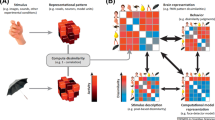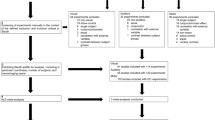Abstract
Spatial descriptions frequently contain ambiguities because they can be interpreted using more than one reference frame. How do people handle such ambiguities? Previous work suggests either serial choice of reference frames or multiple activation of available frames. While behavioral evidence shows mixed support for these positions, a technique of cognitive neuroscience may provide additional insight. The present research examined spatial description processing using an electrophysiological measure, event-related potentials (ERPs). ERP's fine-grained temporal resolution allows examination of cognitive processes as they unfold. A second behavioral study provides comparison results. This initial study indicated that spatial description comprehension relates to semantic integration. Given this interpretation, data also suggested multiple frame activation with then primary selection of the intrinsic reference frame. Results are discussed in a framework of comparing methodological techniques.
Similar content being viewed by others

References
Aguirre, G.K. and D'Esposito, M. (1997). Environmental Knowledge is Subserved by Separable Dorsal/Ventral Neural Areas, Journal of Neuroscience 17(7): 2512–2518.
Bentin, S., McCarthy, G. and Wood, C.C. (1985). Event-Related Potentials Associated with Semantic Priming, Electroencephalography and Clinical Neurophysiology 60: 343–355.
Carlson-Radvansky, L.A., Covey, E.S. and Lattanzi, K.M. (1999). “What” Effects on “Where”: Functional Influences on Spatial Relations, Psychological Science 10(6): 516–521.
Carlson-Radvansky, L.A. and Irwin, D.E. (1993). Frames of Reference in Vision and Language, Cognition 46: 223–244.
Carlson-Radvansky, L.A. and Irwin, D.E. (1994). Reference Frame Activation during Spatial Term Assignment, Journal of Memory and Language 33: 646–671.
Carlson-Radvansky, L.A. and Jiang, Y. (1998). Inhibition Accompanies Reference-Frame Selection, Psychological Science 9(5): 386–391.
Carlson-Radvansky, L.A. and Logan, G.D. (1997). The Influence of Reference Frame Selec-tion on Spatial Template Construction, Journal of Memory and Language 37: 411–437.
Coles, M.G.H. and Rugg, M.D. (1995). Event-Related Potentials: An Introduction. In M.D. Rugg and M.G.H. Coles (eds.), Electrophysiology of Mind. New York: Oxford University Press, pp. 1–26.
Donchin, E. (1981). “Surprisep ...Surprise?” Psychophysiology 18(5): 493–513.
Donchin, E. and Coles, M.G. (1991). Behavior, Cognition, and Event-related Brain Potential, Behavioral & Brain Sciences 14(4): 735–739.
Eimer, M.(1999). Can Attention be Directed to Opposite Locations in Different Modalities? An ERP Study, Clinical Neurophysiology 110(7): 1252–1259.
Faust, R.R., Naylor, S.J., Taylor, H.A. and Holcomb, P.J. (1998). Distinct Processing of Spatial Reference Frames: Electrophysiological Evidence. Paper presented at the 5th Annual Meeting of the Cognitive Neuroscience Society, San Francisco, CA.
Friederici, A.D. and Levelt, W.J.M. (1987). Resolving Perceptual Conflicts: The Cognitive Mechanisms of Spatial Orientation, Aviation, Space, and Environmental Medicine 58: 164–169.
Garnham, A. (1989). A Unified Theory of the Meaning of Some Spatial Relation Terms, Cognition 31: 45–60.
Hill, C. (1982). Up/Down, Front/Back, Left/Right: A Contrastive Study of Hausa and English. In J. Weissen and W. Klein (eds.), Here and There: Cross-Linguistic Studies on Deixis and Demonstration. Amsterdam: Benjamins, pp. 13–42.
Holcomb, P.J. (1993). Semantic Priming and Stimulus Degradation: Implications for the Role of the N400 in Language Processing, Psychophysiology 30: 47–61.
Holcomb, P.J., Kounios, J. Anderson, J.E. and West, W.C. (1999). Dual Coding, Context Availability, and Concreteness Effects in Sentence Comprehension: An Electrophysiological Investigation, Journal of Experimental Psychology: Learning, Memory and Cognition 25: 721–742.
Kounios, J. and Holcomb, P.J. (1992). Structure and Process in Semantic Memory: Evid-ence from Event-Related Brain Potentials and Reaction Times, Journal of Experimental Psychology: General 121: 459–479.
Kutas, M. and Hillyard, S.A. (1980a). Event-Related Brain Potentials to Semantically Inappropriate Incongruity, Biological Psychology 11: 99–116.
Kutas, M. and Hillyard, S.A. (1980b). Reading Senseless Sentences: Brain Potentials Reflect Semantic Incongruity, Science 207: 203–205.
Kutas, M. and van Petten, C. (1988). Event-Related Brain Potential Studies of Languages. In P.K. Ackles, J.R. Jennings and M.G.H. Coles (eds.), Advances in Psychophysiology,Vol.3. Greenwich, CT: JAI Press, pp. 139–187.
Kutas, M., van Petten, C. and Besson, M. (1988). Event-Related Potential Asymmetries during the Reading of Sentences, Electroencephalography & Clinical Neurophysiology 69(3): 218–233.
Levelt, W.J.M. (1982). Linearization in Describing Spatial Networks. In S. Peters and E. Saarinen (eds.), Processes, Beliefs, and Questions. Dordrecht: Reidel, pp. 199–220.
Levelt, W.J.M. (1984). Some Perceptual Limitations on Talking about Space. In A.J. van Doorn, W.A. van de Grind and J.J. Koenderink (eds.), Limits in Perception. Utrecht, The Netherlands: VNU Science Press, pp. 323–358.
Levelt, W.J.M. (1989). Speaking: From Intention to Articulation.Cambridge,MA: MIT Press.
Levinson, S.C. (1996). Frames of Reference and Molyneux's Question: Crosslinguistic Evidence. In P. Bloom, M.A. Peterson, L. Nadel and M.F. Garrett (eds.), Language and Space. Cambridge, MA: The MIT Press, pp. 109–170.
Linde, C. and Labov, W. (1975). Spatial Networks as a Site for the Study of Language and Thought, Language 51: 924–940.
Miller, G.A. and Johnson-Laird, P.N. (1976). Language and Perception.Cambridge,MA: Harvard University Press.
Neville, H.J., Kutas, M., Chesney, G. and Schmidt, A.L. (1986). Event-Related Brain Potentials during Initial Encoding and Recognition Memory of Congruous and Incongruous Wor ds, Journal of Memory and Language 25(1): 75–92.
Schober, M.F. (1993). Spatial Perspective-Taking in Conversation, Cognition 47: 1–24.
Schober, M.F. (1996). Addressee-and Object-Centered Frames of Reference in Spatial Descriptions. In P.L. Olivier (ed.), Cognitive and Computational Models of Spatial Representation: Papers from the 1996 AAAI Spring Symposium. Menlo Park, CA: The AAAI Press.
Schober, M.F. and Bloom, J.E. (1995). The Relative Ease of Producing Egocentric, Addressee-Centered, and Object-Centered Spatial Descriptions. Paper presented at the Annual Meeting of the Psychonomics Society, Los Angeles, CA.
Van Petten, C. and Kutas, M. (1990). Interactions between Sentence Context and Word Frequency in Event-Related Brain Potentials, Memory & Cognition 18: 380–393.
Author information
Authors and Affiliations
Corresponding author
Rights and permissions
About this article
Cite this article
Taylor, H.A., Naylor, S.J., Faust, R.R. et al. “Could you hand me those keys on the right?” Disentangling spatial reference frames using different methodologies. Spatial Cognition and Computation 1, 381–397 (1999). https://doi.org/10.1023/A:1010035613419
Issue Date:
DOI: https://doi.org/10.1023/A:1010035613419



